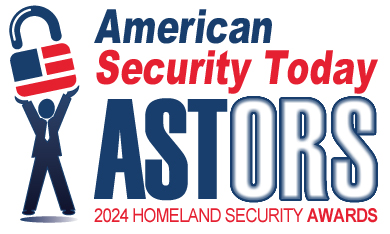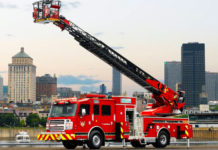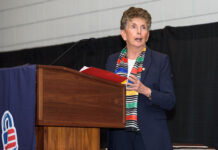The United States needs to be on the front line of livestock animal health research to defend against foreign animal, emerging, and zoonotic diseases.
The National Bio and Agro-Defense Facility (NBAF) is envisioned as a state-of-the-art biosafety level (BSL) 3 and 4 facility that will enable the United States to conduct comprehensive research, develop vaccines and antivirals, and provide enhanced diagnostic capabilities to protect our country from numerous foreign animal and emerging diseases.
As a replacement to the aging Plum Island Animal Disease Center (PIADC), NBAF will provide additional capabilities that are not currently available in the United States, including BSL-4 space for livestock and a vaccine development module.
The NBAF will be the nation’s only large animal BSL-4 facility built to safely handle pathogens that do not currently have treatments or countermeasures.

In May 2015, the Department of Homeland Security (DHS) Science and Technology Directorate (S&T) broke ground on the National Bio and Agro-Defense Facility (NBAF) main laboratory space in Manhattan, Kansas.
Scheduled to open in 2023, NBAF will feature advanced laboratory technologies that allow for catastrophic disease research on livestock.
As construction continues, DHS S&T has focused on developing a foundation of valuable partner relationships with stakeholders, including local leaders, agricultural and livestock partners, government, industry and business partners in Kansas and surrounding areas.
One important aim of the NBAF program’s engagement activities is to develop relationships that result in a pipeline of a skilled workers able to support this first-of-its-kind facility in the U.S.
“It is crucial to the facility’s future success that there exists a pool of qualified talent that is able to support NBAF’s laboratory environments, systems, and other infrastructure,” explained NBAF Partnership Development Director Marty Vanier.
Both traditional and non-traditional partnerships may be key to the future success of NBAF in meeting those demands and many others.
(Learn More about Manhattan’s NBAF Facility. Courtesy of AGaminKansas and YouTube. Posted on July 21, 2016)
Shortly after the May 2015 groundbreaking, DHS S&T used its authority under the America COMPETES Act to launch a prize competition (“NBAF Think and Do Challenge”) seeking great ideas from interested problem solvers to help jumpstart the facility’s operational planning activities.
The NBAF Think and Do Challenge offered the opportunity for America’s “thinkers, doers, and entrepreneurs” to provide their best ideas to meet one or more of NBAF’s anticipated needs.
In 2016, DHS S&T selected Manhattan Area Technical College (MATC) as one of the monetary prize winners for its proposal to help establish a qualified talent pool with skills necessary for work within NBAF.
Since that time the MATC has been hard at work developing a Biohazardous Risk Reduction Training program and curriculum designed to help participants become skilled in working safely with systems and laboratory environments like those that will be in place at NBAF and other facilities throughout the region.
Both the NBAF and the MATC are located within the Kansas City Animal Health Corridor (Interstate70 from Manhattan to Columbia, Missouri) placing them within the largest concentration of animal health organizations in the world.

To develop its Biohazardous Risk Reduction Training program, MATC’s design staff worked with guidelines from the Centers for Disease Control and Prevention, the National Institute of Health, and the American Biological Safety Association.
This training is designed for facility technicians and engineers working at NBAF as well as other support laboratories and facilities.
“From the beginning it has been our intent to make certain we understand the needs and standards of NBAF so that we can offer training within their required guidelines,” said Barbara Wenger, MATC Director of Bioscience.
MATC recently piloted its Biohazardous Risk Reduction Training program with two successful exercises. These sessions were offered to bio-technicians and local contractors in the Manhattan area.

The city of Manhattan Code Service saw the potential of this training program and is extending continuing education credits for licensed contractors.
MATC hopes to begin offering the course to the public on a regular and recurring basis.
The next step for MATC is to further develop its Critical Environments Engineering Technician training program, designed to prepare technicians with the knowledge, skills, and abilities to oversee daily laboratory operational needs at NBAF and other facilities.
This includes teaching the skills necessary to work with the facility’s air handling systems, electronics, building automation, and maintenance of high-containment biosafety level laboratory spaces.
“The [Manhattan Area] Technical College has been a terrific partner to NBAF. Their work is helping us lean in to important operational planning”, said NBAF Operational Planning Manager, Timothy Burke.
In recent years, the Kansas City Animal Health Corridor has witnessed a rate of growth in biotechnology and pharmaceutical industries with the need to maintain or grow relevant skills for over 20,000 employees.
(The KC Animal Health Corridor is the largest concentration of animal health industry assets in the world. It spans from Manhattan, Kansas to Columbia and St. Joseph, Missouri. More than one-third of sales from the global $19 billion industry are generated from companies within the KS/MO Corridor. Courtesy of the KC Animal Health Corridor and YouTube. Posted in 2011)
MATC’s expanded program will blend HVAC, mechatronics and process management courses into a program that will not only align with high containment laboratories, but also with growing trends in industrial maintenance.
The NBAF Think and Do Challenge prize funding allowed MATC to plan and develop opportunities for future support of these industries.
A variety of public and private organizations stand to benefit from the qualified talent MATC’s new training programs will provide.
New relationships with local and regional groups, contractors working with NBAF and other labs, and additional donations helping MATC to further refine its program will help develop an ecosystem of qualified talent capable of supporting NBAF and its partners.
“We recognized early on that there will be a host of partners in academia, private industry, and beyond who support NBAF.
This further motivated us to develop the most relevant and impactful training possible,” said Wenger.
Through its use of the prize competition and collaboration with MATC, DHS S&T has established an important relationship that helps meet some of the most important future needs of NBAF and its regional partners.
Learn More…
Five New Powerful Tools to Combat Agroterrorism & FADs (Learn More)
















